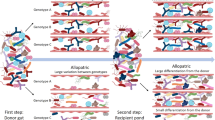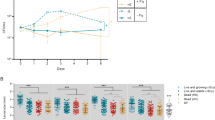Abstract
The symbiotic gut microbial community is generally known to have a strong impact on the fitness of its host. Nevertheless, it is less clear how the impact of symbiotic interactions on the hosts’ fitness varies according to environmental circumstances such as changes in the diet. This study aims to get a better understanding of host–microbiota interactions under different levels of food availability. We conducted experiments with the invertebrate, experimental model organism Daphnia magna and compared growth, survival and reproduction of conventionalized symbiotic Daphnia with germ-free individuals given varying quantities of food. Our experiments revealed that the relative importance of the microbiota for the hosts’ fitness varied according to dietary conditions. The presence of the microbiota had strong positive effects on Daphnia when food was sufficient or abundant, but had weaker effects under food limitation. Our results indicate that the microbiota can be a potentially important factor in determining host responses to changes in dietary conditions. Characterization of the host-associated microbiota further showed that Aeromonas sp. was the most prevalent taxon in the digestive tract of Daphnia.
Similar content being viewed by others
Log in or create a free account to read this content
Gain free access to this article, as well as selected content from this journal and more on nature.com
or
References
Bakke I, De Schryver P, Boon N, Vadstein O . (2011). PCR-based community structure studies of Bacteria associated with eukaryotic organisms: a simple PCR strategy to avoid co-amplification of eukaryotic DNA. J Microbiol Methods 84: 349–351.
Bates JM, Mittge E, Kuhlman J, Baden KN, Cheesman SE, Guillemin K . (2006). Distinct signals from the microbiota promote different aspects of zebrafish gut differentiation. Dev Biol 297: 374–386.
Belden LK, Harris RN . (2007). Infectious disease in wildlife: the community ecology context. Front Ecol Environ 5: 533–539.
Ben-Yosef M, Behar A, Jurkevitch E, Yuval B . (2008). Bacteria-diet interactions affect longevity in the medfly – Ceratitis capitata. J Appl Entomol 132: 690–694.
Birch LC . (1948). The intrinsic rate of natural increase of an insect population. J Anim Ecol 17: 15–26.
Caporaso GJ, Kuczynski J, Stombaugh J, Bittinger K, Bushman FD, Costello EK et al. (2010). QIIME allows analysis of high-throughput community sequencing data. Nat Methods 7: 335–336.
Clemente JC, Ursell LK, Parfrey LW, Knight R . (2012). The impact of the gut microbiota on human health: an integrative view. Cell 148: 1258–1270.
Crawford PA, Crowley JR, Sambandam N, Muegge BD, Costello EK, Hamady M et al. (2009). Regulation of myocardial ketone body metabolism by the gut microbiota during nutrient deprivation. PNAS 106: 11276–11281.
Daskin JH, Alford RA . (2012). Context-dependent symbioses and their potential roles in wildlife diseases. Proc R Soc Lond B Biol Sci 279: 1457–1465.
Decaestecker E, Gaba S, Raeymaekers JAM, Stoks R, Van Kerckhoven L, Ebert D, De Meester L . (2007). Host-parasite “Red Queen” dynamics archived in pond sediment. Nature 450: 870–873.
DeSantis TZ, Brodie EL, Moberg JP, Zubieta IX, Piceno YM, Andersen GL . (2007). High-density universal 16S rRNA microarray analysis reveals broader diversity than typical clone library when sampling the environment. Microb Ecol 53: 371–383.
de Vries EJ, Jacobs G, Sabelis MW, Menken SBJ, Breeuwer JAJ . (2004). Diet-dependent effects of gut bacteria on their insect host: the symbiosis of Erwinia sp. and western flower thrips. Proc R Soc Lond Biol Sci 271: 2171–2178.
Dillon RJ, Webster G, Weightman J, Charnley AK . (2010). Diversity of gut microbiota increases with aging and starvation in the desert locust. Antonie van Leeuwenhoek 97: 69–77.
Douglas AE . (2010) The symbiotic habit. Princeton University Press: Princeton, NJ, USA..
Dudycha JL . (2003). A multi-environment comparison of senescence between sister species of Daphnia. Oecologia 135: 555–563.
Eckert EM, Pernthaler J . (2014). Bacterial epibionts of Daphnia: a potential route for the transfer of dissolved organic carbon in freshwater food webs. ISME J 8: 1808–1819.
Freese HM, Schink B . (2011). Composition and stability of the microbial community inside the digestive tract of the aquatic crustacean Daphnia magna. Microb Ecol 62: 882–894.
Glazier DS, Calow P . (1992). Energy allocation rules in Daphnia magna: clonal and age differences in the effects of food limitation. Oecologia 90: 540–549.
Gorokhova E, Rivetti C, Furuhagen S, Edlund A, Ek K, Breitholtz M . (2015). Bacteria-mediated effects of antibiotics on Daphnia nutrition. Environ Sci Technol 49: 5779–5787.
Grossart HP, Dziallas C, Leunert F, Tang KW . (2010). Bacteria dispersal by hitchhiking on zooplankton. PNAS 107: 11958–11964.
Guillard RRL, Lorenzen CJ . (1972). Yellow-green algae with chlorophyllide C. J Phycol 8: 10–14.
Handley KM, VerBerkmoes NC, Steefel CI, Williams KH, Sharon I, Miller CS et al. (2013). Biostimulation induces syntrophic interactions that impact C, S and N cycling in a sediment microbial community. ISME J 7: 800–816.
Hoffmann F, Radax R, Woebken D, Holtappels M, Lavik G, Rapp HT et al. (2009). Complex nitrogen cycling in the sponge Geodia barretti. Environ Microbiol 11: 2228–2243.
Kasalický V, Jezbera J, Hahn MW, Šimek K . (2013). The diversity of the Limnohabitans genus, an important group of freshwater bacterioplankton, by characterization of 35 isolated strains. PLoS one 8: e58209.
Klüttgen BU, Dulmer U, Engels M, Ratte HT . (1994). ADaM, an artificial freshwater for the culture of zooplankton. Water Res 28: 743–746.
Kohl KD, Dearing MD . (2012). Experience matters: prior exposure to plant toxins enhances diversity of gut microbes in herbivores. Ecol Lett 15: 1008–1015.
Martin-Creuzburg D, Beck B, Freese HM . (2011). Food quality of heterotrophic bacteria for Daphnia magna: evidence for a limitation by sterols. FEMS Microbiol Ecol 76: 592–601.
Miner BE, De Meester L, Pfrender ME, Lampert W, Hairston NG . (2012). Linking genes to communities and ecosystems: Daphnia as an ecogenomic model. Proc R Soc Lond Biol Sci 279: 1873–1882.
Moheimani NR, Borowitzka MA, Isdepsky A, Sing FS . (2013) Standard methods for measuring growth of algae and their composition. In: Borowitzka MA, Moheimani MR (ed). Algae for biofuels and Energy, Developments in applied Phycology 5. Springer Science+Business media: Dordrecht, the Netherlands, pp 265–284.
Müller-Navarra D, Lampert W . (1996). Seasonal patterns of food limitation in Daphnia galeata: separating food quantity and food quality effects. J Plankton Res 18: 1137–1157.
Ohkuma M . (2008). Symbioses of flagellates and prokaryotes in the gut of lower termites. Trends Microbiol 16: 345–352.
Peerakietkhajorn S, Tsukada K, Kato Y, Matsuura T, Watanabe H . (2015). Symbiotic bacteria contribute to increasing the population size of a freshwater crustacean, Daphnia magna. Environ Microbiol Rep 7: 364–372.
Peerakietkhajorn S, Kato Y, Kasalicky V, Matsuura T, Watanabe H . (2015b). Betaproteobacteria Limnohabitans strains increase fecundity in the crustacean Daphnia magna: Symbiotic relationship between major bacterioplankton and zooplankton in freshwater ecosystem. Environ Microbiol 27: 2015; doi:10.1111/1462-2920.12919.
Pietrzak B, Grzesiuk M, Bednarska A . (2010). Food quantity shapes life history and survival strategies in Daphnia magna (Cladocera). Hydrobiologia 643: 51–54.
Pruesse E, Peplies J, Glöckner FO . (2012) . SINA: accurate high-throughput multiple sequence alignment of ribosomal RNA genes. Bioinformatics 28: 1823–1829.
Qi W, Nong G, Preston JF, Ben-Ami F, Ebert D . (2009). Comparative metagenomics of Daphnia symbionts. BMC Genomics 10: 172.
Rochelle PA, Will JAK, Fry JC, Jenkins GJS, Parkes RJ, Turley CM, Weightman AJ . (1995) and amplification of 16S rRNA genes from deep marine sediments and seawater to assess bacterial community diversity. In: van Elsas JD, Trevors JT (ed). Nucleic Acids in the Environment. Springer: Berlin, Germany, pp, 219–239.
Roeselers G, Mittge EK, Stephens WZ, Parichy DM, Cavanaugh CM, Guillemin K, Rawls JF . (2011). Evidence for a core gut microbiota in the zebrafish. ISME J 5: 1595–1608.
Shaw AK, Halpern AL, Beeson K, Tran B, Venter JC, Martiny JB et al. (2008). It's all relative: ranking the diversity of aquatic bacterial communities. Environ Microbiol 10: 2200–2210.
Sabree ZL, Kambhampati S, Moran NA . (2009). Nitrogen recycling and nutritional provisionig by Blattabacterium, the cockroach endosymbiont. PNAS 106: 19521–19526.
Sison-Mangus MP, Mushegian AA, Ebert D . (2014). Water fleas require microbiota for survival, growth and reproduction. ISME J 9: 59–67.
Taipale SJ, Brett MT, Pulkkinen K, Kainz MJ . (2012). The influence of bacteria-dominated diets in Daphnia magna somatic growth, reproduction, and lipid composition. FEMS Microbiol Ecol 82: 50–62.
Tokuda G, Elbourne LDH, Kinjo Y, Saitoh S, Sabree Z, Hojo M et al. (2013). Maintenance of essential amino acid synthesis pathways in the Blattabacterium cuenoti symbiont of a wood-feeding cockroach. Biol Lett 9: 20121153.
Vanoverbeke J . (2008). Modeling individual and population dynamics in a consumer-resource system: Behavior under food limitation and crowding and the effect on population cycling in Daphnia. Ecol Model 216: 385–401.
Weisburg WG, Barns SM, Pelletier DA, Lane DJ . (1991). 16S ribosomal DNA amplification for phylogenetic study. J Bacteriol 173: 697–703.
Wilson KH, Blitchington R, Greene R . (1990). Amplification of bacterial 16S ribosomal DNA with polymerase chain reaction. J Clin Microbiol 28: 1942–1946.
Zhang C, Li S, Yang L, Huang P, Li W, Wang S et al. (2013). Structural modulation of gut microbiota in life-long calorie-restricted mice. Nat Comm 4: 1–10.
Acknowledgements
We thank Luc De Meester and Dieter Ebert for stimulating discussions. Funding was provided by the research projects: FWO G.0643.13, Belspo IAP project SPEEDY, P7/4 and the Centre of Excellence SEEDS PF/2010/007 of the KULeuven Research Fund.
Author information
Authors and Affiliations
Corresponding author
Ethics declarations
Competing interests
The authors declare no conflict of interest.
Additional information
Supplementary Information accompanies this paper on The ISME Journal website
Supplementary information
Rights and permissions
About this article
Cite this article
Callens, M., Macke, E., Muylaert, K. et al. Food availability affects the strength of mutualistic host–microbiota interactions in Daphnia magna. ISME J 10, 911–920 (2016). https://doi.org/10.1038/ismej.2015.166
Received:
Revised:
Accepted:
Published:
Issue date:
DOI: https://doi.org/10.1038/ismej.2015.166
This article is cited by
-
Natural populations of the putative ancient asexual Darwinula stevensoni (Crustacea, Ostracoda) differ in their microbiomes
Hydrobiologia (2023)
-
Host-Associated Bacterial Communities Vary Between Daphnia galeata Genotypes but Not by Host Genetic Distance
Microbial Ecology (2023)
-
Disentangling Diet- and Medium-Associated Microbes in Shaping Daphnia Gut Microbiome
Microbial Ecology (2022)
-
Locally adapted gut microbiomes mediate host stress tolerance
The ISME Journal (2021)
-
Characterization of key bacterial species in the Daphnia magna microbiota using shotgun metagenomics
Scientific Reports (2020)



